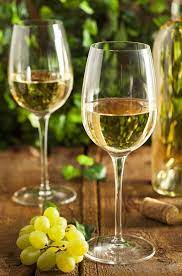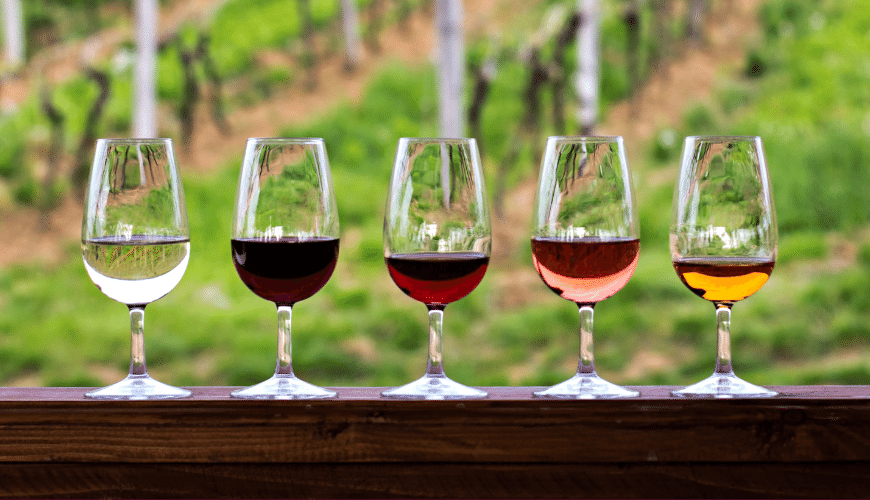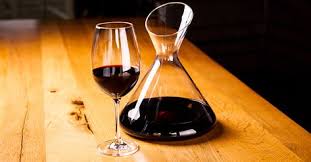Novice and experienced wine drinkers share the need for basic wine knowledge, particularly when it comes to entertaining. I will say I am definitely on the novice side of the table when it comes to this, but I have learned tons of new information, just with research! And I’m having FUN with it! I certainly believe, that with this basic knowledge and understanding, you will be able to confidently select, buy, and serve wine.
Did you know that winemakers use a specific type of grape, known as vitis vinifera, to make wine? That was definitely new information for me. These grapes are different from the table grapes you eat; they are smaller and more concentrated than table grapes, and they have less moisture. They also tend to have more seeds and thicker skins. These grapes are sweeter than table grapes, because the sugars need to ferment into alcohol. Vitis vinifera are either black-skinned or bronze-skinned to make red and white wine.
Wines are broken into various types
- Red wines are made from black-skinned grapes and can range from dry to sweet. Their coloring comes from the juice being left in contact with the skin for part of the winemaking process.
- White wines are made from bronze-skinned grapes and can range from dry to sweet.
- Blush or rosé wines are made mostly from black-skinned grapes or from a blend of bronze and black grapes.
- Sparkling wines can be red, white, or rosé, although whites and rosés are the most common. Sparkling wines are made via various methods and include popular varieties such as Champagne, Prosecco, Sekt, and Cava among others. They can range from dry to sweet.
- Fortified wines are made by adding neutral grape spirits to wine to increase the alcohol level, and sometimes sugar is added. Wines such as Port and Sherry are fortified wines.
- Fortified aromatized wines are made by adding neutral grape spirits, botanicals, and possibly sugar to wine. Vermouth is a classic example of a fortified aromatized wine.
- Single varietal wines contain just one grape.
- Wine blends are made by blending different varietals together.
White Wine Knowledge
Strong Whites
Chardonnay’s specific tastes and aromas can change depending on the brand, the wine generally has strong fruity flavors. Typically, it has hints of green apple, pear, melon, creamy lemon, and rounded out with vanilla. It pairs well with a variety of food options, such as shellfish, grilled lobster, tilapia, vegetables, and dishes with rich sauces. Its bold body, lack of acidity, rich and creamy texture make it an excellent option for the above choices.
Light Whites
Off-Dry Riesling is a delicate white wine that holds flavors of white peach, green apple, and lime and its light sweetness makes it a perfect complementary pairing for spicy dishes. Its semi-sweet taste has the ability to tame the heat of spicy dishes. Off-Dry Riesling also pairs well with shellfish, pork, ham, and salads. Its lack of tannins and therefore bitterness make it a great pairing for salads with vinaigrettes. This is the case because bitter vinaigrettes paired with bitter wine will only enhance the bitterness of both the food and wine.
Sauvignon Blanc, as a light bodied white wine, tends to be high in acidity and offer a crisp white taste. This allows for it to pair well with tart dressings and sauces, cheese, oysters, fresh herbs and delicate fish. The pairing options here demonstrate how high acidity wine and food can compliment each other well. This allows you to notice the natural flavors since they are not competing.
Pinot Grigio’s light and crisp taste is the perfect option for light seafood. With hints of pears, lemons, melons, and sweet spice, it creates a delicious white wine. It’s important to pair delicate fish with delicate wines, because the wrong choice in food or wine can overpower the taste of the other. As a result you can end up with a great wine tasting bland because of the overpowering flavors of the food choice. Along with fish, Pinot Grigio also pairs well with pasta, grilled chicken and dishes with fresh herbs.
Red Wine Knowledge
Dry Rosé is one of the most diverse wines with its ability to have characteristics of both red and white wine. This allows for Dry Rosé to pair well with almost any cheese because of its acidity and fruity traits. As a crisp pink wine it offers a refreshing taste with low amounts of tannin and therefore little bitterness. Dry Rosé’s flavors include hints of strawberries, cherries, citrus, and herbs. This allows for it to pair well with grilled chicken and spicy seafood.
Cabernet Sauvignon, as a full body red wine, Cabernet Sauvignon is high with tannins, plum, black berry, and black currant flavors. This gives it its dark fruity taste that even becomes more mature with time. The strong tannins make it a great choice for steak or lamb chops because of its ability to refresh your palate after each bite.
Pinot Nior has a light body and earthy flavors. These flavors consist of dark berries, cherries, plums, violets, and warm spices. This red wine stands apart form others, with very few tannins it pairs perfectly with fatty fish. This includes salmon and tuna among others. Along with fish, it pairs well with lamb, venison, and pork chops.
Syrah, this red wine is the perfect congruent pairing for spicy dishes. With a spicy flavor profile itself, it pairs well with barbeque, lamb and grilled meats. The important thing to consider when pairing Syrah wines is the spice level of both the food and the wine. If the food is significantly spicer than the wine it will overpower it and cause the wine to lose its spicy profile and taste flavorless.
Sparkling Wine Knowledge
Sparkling Wine is common among celebratory occasions. However, sparkling wines pair well with a variety of different foods. Especially salty foods and even fried ones. This is the case because the carbonation in sparkling wine cuts through the saltiness and perfectly balances out the meal. Sparkling wine also pairs well with roasted vegetables and fish.
Tasting and Drinking Wine Knowledge
When you taste wine, there are several aspects that should stand out:
- Body describes the texture or density of the wine.
- Acidity describes tart or “sour” flavors in wine.
- Tannins add bitterness and sharpness to the wine and also allow wines to age.
- Alcohol adds a “hotness” to the wine; it is the result of fermentation. Alcohol measurement ranges anywhere from about 5.5 percent to 23 percent for some fortified wines.
- Sweetness is how you perceive the sugar in the wine. Wine can be very dry, very sweet, or anywhere in between.
- Aromas are the fragrances you smell in the wine. They also affect how the wine tastes. Aromas come in a wide range including floral, herbal, earthy, fruity, or spicy.
- Flavors are the way the wine tastes on your tongue. Flavors may be any of the aromas, and they may also include meaty, buttery, salty, oaky, or vegetal.
- Finish describes how the wine lingers on the palate and what flavors come after drinking the wine.
Choosing Wine for a Dinner
Now comes the fun part! When it comes to serving a wine for dinner, finding the right food pairing can help. It is always a plus to have options! That being said, sometimes I choose 2 wines, one for the meal and one for dessert. It’s just fun to do it that way, then my guests get to taste 2 different wines from my collection. You can read more about pairing food and wine here!
Food Pairing Rules
SO, when you think about it, who said there were “rules” for pairing wine with food? The only person you really need to please is yourself, right? Thus, drink what you like with what you eat. That sounds pretty fair. However, a great food and wine pairing can bring out the best in both components if you pair heavier foods with heavier wines and lighter foods with lighter wines. For example, if you serve a crisp summer seafood salad, it will get be overwhelmed by a hearty Cabernet Sauvignon. And a light, fruity Pinot Grigio would be lost if you paired it with a New York strip steak. Flip those around and you have two great pairings.
Wines for a Party
Planning a Party? Wine tasting parties are great. It is great fun choosing your appetizers and then choosing your wines to go with them. For great ideas on awesome charcuterie boards, check this out! Now you can add your wine knowledge with these popular wine selections for parties:
- Choose Chardonnay or Pinot Grigio for whites.
- Choose Merlot or Cabernet Sauvignon for reds.
- For an affordable sparkling wine, choose Prosecco or Spanish Cava.
When you are trying to calculate how much wine to buy, you need to put into an equation. In other words, you are having a cocktail party, and assume each guest will drink a 5oz glass every hour. If you are inviting 15 people and plan a 2 hour party, that is 5oz times 2 hours. So, each person at the cocktail is now drinking 10oz of wine. Now, multiply the 10oz by 15 guests, which equals a total of 200oz of wine needed, and divide that by 25, the approximate number of oz in 1 bottle of wine. The result is that 6 bottles of wine are what we need for your cocktail party.
Serving Wine Knowledge
We’ve come to the point where you determine the best way to serve your wine. That, my friends, I believe is relatively easy, because the type of wine will best determine the way to serve it. If you are looking for new glassware, I have done a bit of research on that too. Check that out here! Each wine has a type of glass that helps bring out the flavors! WHO KNEW??
- In general, you can serve red wines at slightly below room temperature; about 60°F to 65°F
- White wines you chill, they are better between 45°F and 50°F.
- Sparkling wines are better even cooler, at about 40°F to 45°F.
Consult a wine temperature chart for specific wines. You can chill wines rapidly by soaking the bottle in a mix of ice and water for about 20 minutes.
Decanting
You don’t have to decant your wine, but you may come across a couple of situations where decanting might just be necessary. If you have a bottle of wine that is 10 or more years, like an older vintage port, you might want to decant that to remove the sediment. Another reason to decant a wine is to aerate your wine. This softens young tannic wines like Cabernet Sauvignon. The harsh or dry finish you get from these youthful reds will definitely become softer when you decant them.
Apply What You Know
Applying the tips and suggestions that I have laid out here will now help you make informed decisions and allow you to select, purchase and choose wine with confidence. With a little wine knowledge, you’ll soon be picking and serving wines like a pro. I know I will!
Now that you have built up your knowledge on wine, It is time to build you wine collection. Let me tell you that we have a Wine of the Month Club, and you can learn all about it HERE!!! Your Fine Wine can come straight to your your front door just for being a customer! Furthermore, refer 3 new customers and your wine is FREE the next month. YES, you heard that right, FREE! Why wouldn’t you want free Wine! Join Now and Start Enjoying Fabulous Wine!!!







